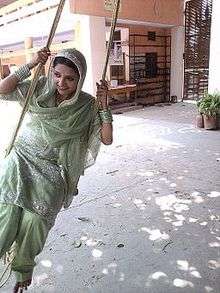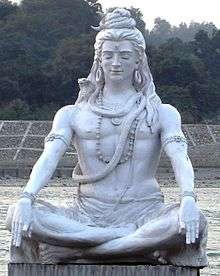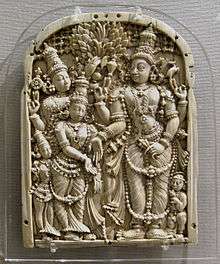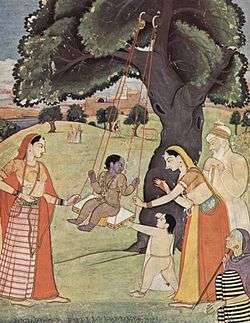Teej
Teej is the generic name for a number of Hindu festivals that are celebrated by women in many parts of India (mainly in North and Central India) and Nepal. Haryali Teej and Hartalika Teej welcome the monsoon season and are celebrated primarily by girls and women, with songs, dancing and prayer rituals.[1] The monsoon festivals of Teej are primarily dedicated to Parvati and her union with Shiva.[1] In this festival woman follow a ritual of not eating anything for long life of her husband.
| Hari talika teej | |
|---|---|
 Women celebrating Teej in Nepal | |
| Also called | Monsoon Festival/Dedicated to Parvati |
| Observed by | Hindu women |
| Type | Monsoon festivals |
| Celebrations | wearing colorful dress maxima people using red because red is a symbol of love |
| Begins | Haryali Teej: Third day of the bright half of the lunar month of Shraavana. Kajari Teej: the third day of the dark fortnight of Bhadrapada. Hartalika Teej: third day of the bright half of Bhadrapada. |
| Date | July/August/September |
Etymology
_spotted_at_Kambalakonda_01.jpg)
Teej refers to the third day that falls every month after the new moon (amavasya), and the third day after the full moon night of every month.[2] The monsoon festivals of Teej include Haryali Teej, Kajari Teej and Hartalika Teej.[3]
Teej refers to the monsoon festivals, observed particularly in western and northern states of India and Nepal. The festivals celebrate the bounty of nature, arrival of clouds and rain, greenery and birds with social activity, rituals and customs.[4] The festivals for women, include dancing, singing, getting together with friends and telling stories, dressing up with henna-coloured hands and feet, wearing red, green or orange clothes, sharing festive foods,[4] and playing under trees on swings on Haryali Teej.[5]
The festivals are dedicated, in many parts of India and Nepal, to Parvati.[4]
Types of Teej
Teej festivals are traditionally observed by women to celebrate the monsoons, on the third day of the Indian month of Shravan,[1] and on the third days of the waning and waxing moon of the Indian month of Bhadrapada. Women also pray to Parvati seeking the wellness of their husband,[6][7] children and their own self.[1]
Haryali Teej
Haryali Teej (lit. Green Teej) is celebrated on the third day after the full moon in the month of Shraavana/Sawan (of the Hindu calender). As Shraavana falls during monsoon or rainy season when the surroundings become green, the Shraavana Teej is also called Hariyali Teej. A fast is kept and the focus is the moon.
The Hariyali Teej festival is also celebrated to remember the reunion of Shiva and Parvati, the day when Shiva accepted Parvati as his wife. Parvati fasted and was austere for many years and was accepted by Shiva as his wife in her 108 birth. Parvati is also known as Teej mata (lit. Teej mother).[8]
Sindhara Teej
On Sindhara Teej married daughters receive the gifts by her mother such clothes, bangles, bindi, mehandi, etc. Ghevar, a special sweet, are given to them on this day. These gifts are known as Sindhara[9]
Observance of Haryali Teej
The traditional areas of celebration are: Punjab region and Rajasthan.
Punjab region

Haryali Teej is a festival when girls play on swings that are set up under trees or open courtyards. During Teej, in-laws, husbands and other family members give gifts, typically new clothes and accessories, to girls and women. Boys fly kites. prepare churma and sweets especially ghevar at their home.[10]
The festival is celebrated in Punjab, Haryana and Chandigarh.
Chandigarh
Chandigarh administration makes special arrangements for Teej celebration in the Rock Garden in the city. School children present plays and other cultural programs on this day. The female members of the family, especially daughters, are given gifts and dresses.[11]
Haryana
Haryali Teej is one of the famous festivals of Haryana, and is celebrated as an official holiday. Many functions are organised by the Government of Haryana to celebrate this festival, which welcomes the rainy season. Boys traditionally flew kites from morning to evening, though this tradition is losing its charm in big cities due to high rise buildings and lack of terrace space.
Swings are set up in open courtyards, under trees for the season. Girls apply henna to their hands and feet and are excused from household chores on this day. On Teej, girls often receive new clothes from their parents.
On Teej, just as on Karva Chauth, the mother sends a baya or gift. The puja is performed in the morning. The baya, which consists of a variety of foodstuffs, is placed on a thaali at a place of worship where a chowk (square) has been decorated, and an idol or picture of Parvati has been installed.[12] The evenings are set aside for folk singing and dancing, including the women's prayers for their husbands' longevity and their families.
Punjab

Teej is known as teeyan in Punjab and is seen as a seasonal festival which is dedicated to the onset of the monsoon.[13] The festival is celebrated by women of all faiths, and lasts from the third day of the bright half of the lunar month of Sawan as per the Punjabi calendar to the full moon of Sawan (about 13 days). Teeyan involves women getting together and performing Gidda, married women visiting their families and receiving gifts. It is also traditional for women to ride on swings.
Fairs are organised in Schools and Colleges where dance competitions are held.[14]
Rajasthan
Teej welcomes the monsoon and observed in the month of Shravan (July/August). The monsoon rains fall on the parched land and the pleasing scent of the wet soil rises into the air. Swings are hung from trees and women dressed in green clothes sing songs in celebration of the advent of the monsoon.[4]
This festival is dedicated to Parvati, commemorating her union with Shiva.[4] Parvati is worshipped by seekers of conjugal bliss and happiness. An elaborate procession is taken out in Jaipur[15] for two consecutive days on the festive occasion which is watched by people in large numbers. The Teej idol is covered with a canopy whereas the Gangaur idol is open. The traditional ghevar sweet is also associated with the festival.
During Teej, the Parvati is worshipped. The day before Haryali Teej, is celebrated as Sinjara, wherein women put mehandi on their hands and eat .
Kajari Teej

Kajari Teej is celebrated in the North Indian Lunar month of Bhadrapud: the third day of the dark fortnight of Bhadrapada.[16] Kajari Teej is also called Boorhi Teej.[17] In Rajasthan, Kajari Teej is called Badi Teej (lit. Bigger Teej)[18] as it follows Haryali Teej, which is known as Chhoti Teej (lit. Smaller Teej).
Women in Uttar Pradesh pray to Shiva on Kajari Teej.[19] It is also customary to sing folk songs known as kajris. The focus of the lyrics is usually on separation expressing the pining of a woman for her beloved in her parents' home, where she has been sent to celebrate Teej,[20] or waiting in anticipation to be collected by brothers to celebrate Teej.[21] The kajri is a folk song composed and sung in the regions of eastern Uttar Pradesh, Bihar and in parts of Madhya Pradesh and Rajasthan.[22]
Women who observe the Kajari Teej fast go without food and water.[23] Kajari Teej is associated closely with Kajali Teej, which also involves praying to the moon. The fast is broken by eating sattu.[24] The other focus of the day is to pray to the neem tree. A fair is held in Bundi in Rajasthan to celebrate Kajari Teej.[25]
Hartalika Teej


Hartalika is a combination of the Hindi words harit and aalika which means "abduction" and "female friend" respectively. According to the legend of Hartalika Teej, Parvati, incarnated as Shailaputri,[26][27][28] was the daughter of Himavat who promised her hand in marriage to Vishnu, at the suggestion of Narada.[29] Upon hearing this, Parvati told her friend of her father's decision whereupon the friend took Parvati to the thick forest[30] so that her father would not marry her to Vishnu against her wish.
On the third day of the bright half of Bhadrapud, Parvati made a shiva lingam out of her hair and prayed. Shiva was so impressed that he gave his word to marry Parvati. Eventually, Parvati was united with Shiva and was married to him with her father's blessing. Since then, the day is referred to as Hartalika Teej as Parvati's female (aalika) friend had to abduct (harit) her in order for the goddess to achieve her goal of marrying Shiva.
Accordingly, Hartalika Teej is seen as a major festival and is celebrated on the third day of the bright half of the North Indian Lunar month of Bhadrapud. The festival women feasting during the evening of Hartalika Teej, praying to Parvati and Shiva, remembering their wedding and staying up all night listening to prayers.[30] The fast (also called nishivasar nirjala vrat) commences during the evening of Hartalika Teej and is broken the next day after a full day's observance which involves women not even drinking water.[31] The focus is on praying to Parvati[32] whom Shiva desired should be worshipped under the name Hartalika.[33]
The main areas of celebration are Rajasthan, Uttar Pradesh, Uttarakhand, Bihar and Jharkhand. In Rajasthan, an idol of Parvati is taken out in procession in the streets accompanied by singing, and music. Hartalika Teej has also spread to parts of Madhya Pradesh and Chhattisgarh.
Hartalika Teej of the north is not to be confused with Hartalika Teej of Maharashtra which is connected to the festival of Gowri Habba.
Elsewhere in India
Akha Teej
Akha Teej (also called Akshaya Tritiya) falls on the third day after full moon in the month of Vaishakha.[34][35] It is an auspicious day of the birthday of Parasurama, the sixth incarnation of Vishnu. On this day Veda Vyas and Ganesha began to write the Mahabharata. Jains celebrate this day to commemorate Tirthankara Rishabha's ending of his fast by consuming sugarcane juice poured into his cupped hands. Akha Teej is observed in many parts of the Indian subcontinent.
Awra Teej of Madhya Pradesh and Chhattisgarh
Awra Teej is celebrated in the month of Vaisakh in parts of Madhya Pradesh and Chhattisgarh. It is not associated with the trio of the monsoon festivals of Teej as the month of Vaisakh occurs during spring.
Jhulan Utsav


Haryali Teej coincides with the swing festival of Jhulan Leela also known as Jhulan Utsav or Hindola Utsav[36] which is associated with Krishna and Radha, and is celebrated at Banke Bihari Temple and other temples in the Vrindavan area of Uttar Pradesh. The festival lasts until Krishna Janmashtami for 13 days.[37]
On the day of Teej, idols of Krishna and Radha are placed on swings in the temples and the focus of Jhulan Leela is religious. The green theme, popular in neighbouring Rajasthan and Haryana on Haryali Teej, can also be seen in the Jhulan Utsav. Idols of Krishna and Radha are dressed in green clothes.
Haryali Teej and Jhulan Utsav fall on the same day, but the Teej is a monsoon festival dedicated to Parvati whereas, Jhulan Utsav is dedicated to Krishna and Radha.
Kajal Teej of Telangana
Teej in Telangana forms part of a wider celebration which is a forerunner to other festivals being celebrated and is known as Kajal Teej. Kajal Teej is one of the Banjara tribe's biggest festivals.[38] It is quite popular in villages and thandas. It is a week-long festival. On day 1 unmarried girls put wheat on a small bamboo basket. On the 7th day of sowing, the festival of Thamoli is celebrated. On the ninth day, an earthen idol is prepared which is taken with all the bamboo baskets in a procession and immersed in a nearby pond or river.
Kevada Teej of Gujrat
Kevada Teej, also known as Kevda Trij, is a festival observed mainly in Gujarat. The festival is celebrated on the third day of the Shukla Paksha (waxing of the moon) of Bhadra in Gujarat. This observance is similar to the Hartalika Teej fast (vrat). Married and unmarried women observe a fast on the day and offer kevada flower (Pandanus: pine screw) to Parvati and Shiva.[39]
Observance in Nepal of Haritalika Teej
Dedicated to Parvati, commemorating her union with Shiva, the festival is celebrated for well-being of spouse and children and purification of one's body and soul. The festival is a three-day-long celebration that combines sumptuous feasts as well as rigid fasting. Teej (also romanised Tij) is celebrated by women, for the long life of her husband and long and firm relationship between them in this life and all the lives to come. It is particularly celebrated by women from various castes of Nepalese society, particularly the Bahun Chettri and others, on the third day after the new moon of the month of Bhadra (mid-August to mid-September)[40] [41] [42]
The folk music and dances add more flavor to traditional values of Teej. Women in red dance and sing in the street, going to temple in holy and fasting mood. Teej is also called Haritalika Teej. This festival is celebrated by Nepali Hindu women all across the world.
Amongst some communities it is viewed as a "festival of sisterhood,"[43] Teej has traditional and modern values as a festival of celebrating good times with siblings. Although it looks like it is celebration of sisterhood because when married women get rare chance to meet with sisters and friends from their birthplace, there is a strong role of brothers to celebrate the festival as they are to call their sisters in this auspicious occasion and cook special food for their sisters, and all the girls enjoy time doing make up to look the best and dance to forget the pain they get from their inlaws, which is expressed in the form of folk songs with particular rhythm.
Traditional values
According to Hindu mythology, Shree Swosthani Bratakatha, Parvati ran away from her home with her friends to jungle as she was afraid that her father Himalaya promised to Vishnu to give his daughter Parvati in marriage. She then went to jungle and started praying Shiva to fulfill her wish to marry him. He said "tathastu" meaning he will fulfill her wish. That was the day of teej when Parvati got her husband as her undying wish. So this day is celebrated to get the husband of their dream by unmarried women and for long, healthy and prosperous life of husband by married women.
First day
The first day of Teej is called Dar Khane Din. On this day the women assemble at one place in their finest attire and start dancing and singing devotional songs. Amidst all this, the grand feast takes place. What is unusual about this day is that the feast is hosted by men. Women, who work hard throughout the year, do not have to do anything that day. That is the day for them to embellish themselves in sorha singaar — dressing up and using make up to the full extent, indulge in good food, and dance. Oftentimes, because women are invited by multiple brothers for the feast, they try to dance off some food before they are ready to eat more. The food served is supposed to be rich and abundant.
This is probably the only day in a year that allows women full freedom of expression. Consequently, women have traditionally used this occasion to express their pains and pang in the songs they sing while dancing. With the advancement of communication and awareness, women these days use this occasion to voice their concerns about social issues and discrimination against women. The jollity often goes on till midnight, after which the 24-hour fast starts.
Second day
The second day is the day of fasting. Some women don't eat or drink food and water while others drink liquids and eat fruit. The fasting is observed by married and unmarried women. Married women abstain strictly from food and drinks with a belief that their devotion to the gods will be blessed with longevity, peace and prosperity of their husband and family. Unmarried women observe the fast with a hope of being blessed with a good husband.
They dress gaily and visit a nearby Shiva temple singing and dancing on the way. The Pashupatinath Temple gets the highest number of devotees. At the temple, women circumambulate the shiva lingam, which symbolizes Shiva, offers the praying with flowers, sweets and coins. The main puja (religious ceremony) takes place with offerings of flowers, fruits, etc., made to Shiva and his wife Parvati, beseeching them to grant their blessing upon the husband and family. The important part of the puja is the oil lamp which should be alight throughout the night. It is believed that by the light of an oil lamp all night will bring peace and prosperity to the husband and family.
Third day
The third day of the festival is Rishi Panchami. After the completion of the previous day's puja, women pay homage to seven saints or sages, offer prayers to deities, and bathe with red mud found on the roots of the sacred datiwan bush, along with its leaves. The Rishi Panchami revolves around the purity of women. It is a time when women cleanse themselves of the possible "sin of touching a man during menstruation."[44] During this festival, which occurs two days after the Tij, the women participate in ritual bathes and puja (worship). One of the defining characteristics of the Tij Festival is the songs the women sing. Traditionally, these songs emphasized the subservient role of women in Nepalese society in addition to reinforcing traditional Hindu ideology of gender relations. Within the past few decades, as Nepal and the surrounding area experiences rapid development and modernization, the Tij songs have become more of a critical commentary on gender relations from women's perspectives. These songs "extend the women's thoughts and experiences of hardships from a intimate conversation to a public setting."[45] The Tij songs allow women to effect change in their respective societies by giving them a public voice.
Sindh
_festival_in_Tharparkar%2C_Sindh.jpg)
The Sindhi community in India and Pakistan celebrate Teej which is known as Teejdi or Teejri.[46] However, Sindhis celebrate Teejri on the third day after the full moon of Sawan.[47][48]
References
- J Mohapatra. Wellness In Indian Festivals & Rituals. p. 125. ISBN 9781482816907.
- Pintchman, Tracy Guests at God's Wedding: Celebrating Kartik among the Women of Benares (2005)
- drikpanchang
- Manju Bhatnagar (1988). "The Monsoon Festival Teej in Rajasthan". Asian Folklore Studies. 47 (1): 63–72. JSTOR 1178252.
- B.K. Sharma, Seema Kulshreshtha, Asad R. Rahmani (2013) Faunal Heritage of Rajasthan, India: General Background and Ecology of Vertebrates
- "Rajasthani women celebrate sinjara on eve of badi teej - The Times of India". The Times Of India.
- The Times of India 23 08 13 Barhka Mathur
- Knopf, 1996 Rajasthan
- Teej Festival: Sindhara Teej
- About Teej
- The Times of India 13 08 2010 Poonam Sharma
- Haryana Times (22 01 2000)
- Good Earth Punjab Travel Guide (2006)
- The Tribune 27 July 2014
- Rajasthan Patrika (14.08.2015) Tripolya bazaar ka khulega raasta, paramprik route se yaegi teej ki savari
- What is Kajari Teej
- Folk-lore, Volume 14. Indian Publications, 1973
- Rajasthan [district Gazetteers].: Bikaner 1972
- Uttar Pradesh District Gazetteers: Kanpur 1989
- Journal, Volume 6, Issue 1. The Academy 1985
- Indian & Foreign Review, Volume 21 1983
- Jain, Jasbir (2006) Narrative of the village: centre of the periphery
- Khare, Ravindra S. (1976) The Hindu Hearth and Home
- Dave, Rajendra Kumar (1992) Society and culture of Marwar
- Brown, Lindsay. Thomas, Amelia. (2008) Rajasthan, Delhi & Agra. Ediz. Inglese
- Gautam, Ahalya (2015) Hindu Goddess Nav Durga Maa: Hindu religion
- Jha, O.P. (2014) Goddess Durga: Gods And Goddesses in India
- drikpanchang
- Arya, Satya Prakash (1975) A Sociological Study of Folklore: Projected Research in Kuru Region (Saharanpur, Muzaffarnagar, Meerut, Bulandshahar, and Bijnor Districts of Western Uttar Pradesh)
- Ramchandran, Shivani (2013) pp 109-111 Bharatiya jayantiyan evam tyohar. Srikrishna Pustak Bhandar. ISBN 9788188514441
- http://www.karwachauth.com/teej.html
- Maharashtra State Gazetteers: Buldhana 1976
- Census of India, 1961: Uttar Pradesh
- Gupte 1994, p. 5
- Gopal, Madan (1990). K.S. Gautam (ed.). India through the ages. Publication Division, Ministry of Information and Broadcasting, Government of India. p. 65.
- Vrindaban gears up for colorful Hindola festiva (15.08.2015) Business Standard
- Jhuland Utsav
- The Banjara: By Shashishekhar Gopal Deogaonkar, Shailaja Shashishekhar Deogaonkar
- Hindustan Times 02 09 2008
- Adhikari, G.B, Debra Skinner, and Dorothy Holland. "The Songs of the Tij: A genre of Critical Commentary for Women in Nepal. Asian Folklore Studies. 53n2 (October 1994).
- Skinner, D. Adhikari, G.B., and Dorothy Holland. "The Songs of the Tij: A genre of Critical Commentary for Women in Nepal. Asian Folklore Studies. 53n2 (October 1994).
- Levy, Robert I. Mesocosm: Hinduism and the Organization of a Traditional Newar City in Nepal. Berkeley: University of California Press, c1990 1990. http://ark.cdlib.org/ark:/13030/ft6k4007rd/
- Basnyat, Aarti. "Not a Tease Anymore." Nepali Times Vol. 263, September 2005.
- Levy, Robert I. Mesocosm: Hinduism and the Organization of a Traditional Newar City in Nepal. Berkeley: University of California Press, c1990 1990. http://ark.cdlib.org/ark:/13030/ft6k4007rd/
- Skinner, Debra, Alfred Pach III, and Dorothy Holland. Selves in Time and Place. Lanham, MD: Rowman & Littlefield Publishers, INC, 1998
- "Teejri set for online debut". Free Press Journal. 6 August 2020. ProQuest document ID 2430594907.
- Jhulelal.com
- Article
| Wikimedia Commons has media related to Teej. |

